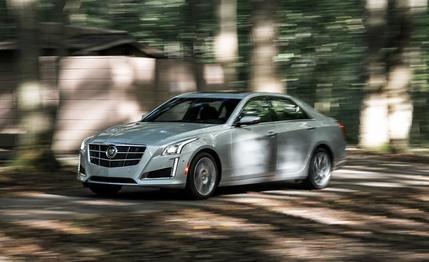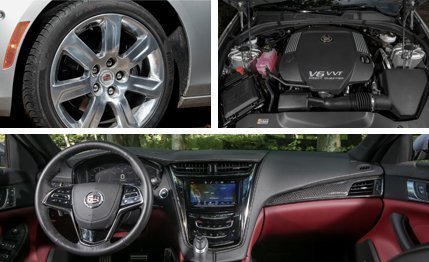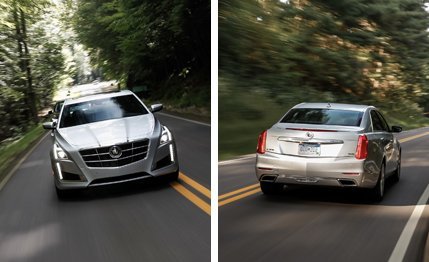 Instrumented Test
TESTED
Instrumented Test
TESTED
The 2014 CTS is proof that Cadillac is learning from the mistakes and missteps of previous decades and—even better—not repeating them. Each successive CTS has been better executed and, well, just better. Careful honing and constant improvement make for great cars, and if you do so long enough, you’ll have built a strong brand. So, yes, the third-generation CTS is better than the last one, but more important, the improvements have placed it among the sports-sedan elite.
Once under way in the CTS, we immediately took notice of the steering. The CTS steers like a sports car—a good sports car. There’s an immediacy and liveliness to the electric-power steering that bestow on the mid-size CTS an ATS-like nimbleness. Suspension tuning is firm, and there’s no waiting for the suspension to take a set. Even with the all-season Pirelli P Zero Nero run-flat tires, the CTS’s chassis is a perfect match to the quick-witted steering. We were a bit surprised by the 3.6’s skidpad grip of 0.83 g, as a twin-turbocharged Vsport model we tested logged a stunning 0.97 g. Yes, the Vsport wore stickier rubber, but that discrepancy is rather large. But even with less-aggressive tires, the strong brakes hauled this 3839-pound sedan to a stop in 158 feet. Balanced handling has always been a part of the CTS’s personality, but what’s impressive about the latest version is that even the mid-level 3.6 has inherited the dynamic spirit and attitude of the previous CTS-V.
Obviously, the naturally aspirated 3.6 doesn’t pack the power of the CTS-V’s supercharged V-8, but the 321-horse V-6 does its best to charge through the torque-converter automatic’s eight forward ratios. Redline shifts are banged off with an enthusiasm matching that of a dual-clutch gearbox, helping this CTS spring from a standstill to 60 mph in 6.0 seconds—1.6 behind the 420-hp Vsport.

Paddle shifters behind the steering wheel allow for manual control should you need or want to keep the transmission in a lower gear longer. This is preferable for sporty driving, as leaving the transmission to its own devices sees it working to find the highest possible gear to maximize fuel economy. In rear-drive guise, the 3.6 is rated by the EPA for 18 mpg city and 29 highway. Opt for all-wheel drive, and a six-speed unit replaces the eight-speeder, and EPA-estimated fuel economy falls to 18/26. For those who might be wondering, there’s not much of a fuel-economy penalty versus the base 2.0-liter turbocharged four-cylinder engine; rear-drive 2.0-liter cars get 20/30, and those with four driven wheels return 19/28. (All four-cylinder cars use a six-speed auto.) It’s worth noting that the V-6 drinks regular fuel, whereas premium is recommended for the blown four.
One thing Cadillac has always done well is isolate occupants from noise, a legacy continued by the CTS. Although the measured decibel level at 70 mph is an unimpressive (for a luxury car) 68 dB, the CTS seems quieter in real-world operation. Suspension, road, and wind noise are muted, and double-paned side glass turns the volume down on the outside annoyances. Simply sit back, relax in the supple seats, and soak in the silence. Only the subtle grind of the V-6 as it spins beyond the 4800-rpm torque peak disturbs the serenity.
If only the interior stylists had turned down the volume on the cabin design, where a chaotic mix of materials looks somewhat disjointed. The materials are of high quality, but there are just so, so many of them: nickel finishes, different leathers, a two-tone color scheme, perforated vinyl, carbon fiber, and piano black were all present in our test car. Given the rest of the car’s excellence, it will at least give Cadillac something to do during the mid-cycle freshening.

Well, the company might also choose to amend the CUE infotainment system, although we have to admit we’re beginning to come to terms with the touch-screen-based setup. One trick we found to reduce our frustration: Make the peekaboo digital “buttons” on the center stack appear permanently. In CUE’s default mode, these controls, which allow you to choose primary functions, only appear as your hand draws near the screen. No matter how many times you’ve used them, it still takes a glance or two away from the road to make sure they’ve appeared and that you’re going to hit the right one. Setting the system so they’re permanently displayed reduces at least one level of guesswork. Still, it’d be nice to have volume and tuning knobs.
We can’t find much to fault with the exterior design. Taut and seemingly windswept, the CTS’s sheetmetal is thoroughly modern without being garish. At night, LEDs accent the front end and arc back into the fenders, their outboard location imparting a powerful sense of width.
The CTS 3.6 starts at $54,625 for a Luxury-grade model (all-wheel drive is $2000). Ordering the Premium bundle of safety gizmos, luxury niceties, and technology gadgets adds $10,800. Stir in the two-tone semianiline leather of our car ($1650), and you basically have a loaded CTS 3.6 for $67,075. (Wheels and paint are the only other options.) For that money, we’re shopping Vsport. That delightful, 420-hp bundle of turbos starts at $59,995 and can be ordered in Premium-spec for $69,995. But keep your checkbox-ticking hand at bay, and the naturally aspirated 3.6 stacks up as a compelling choice in its own right.